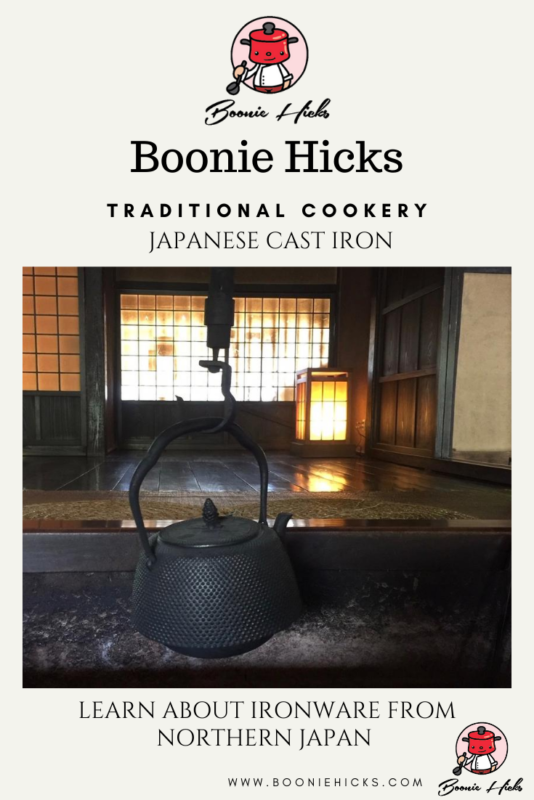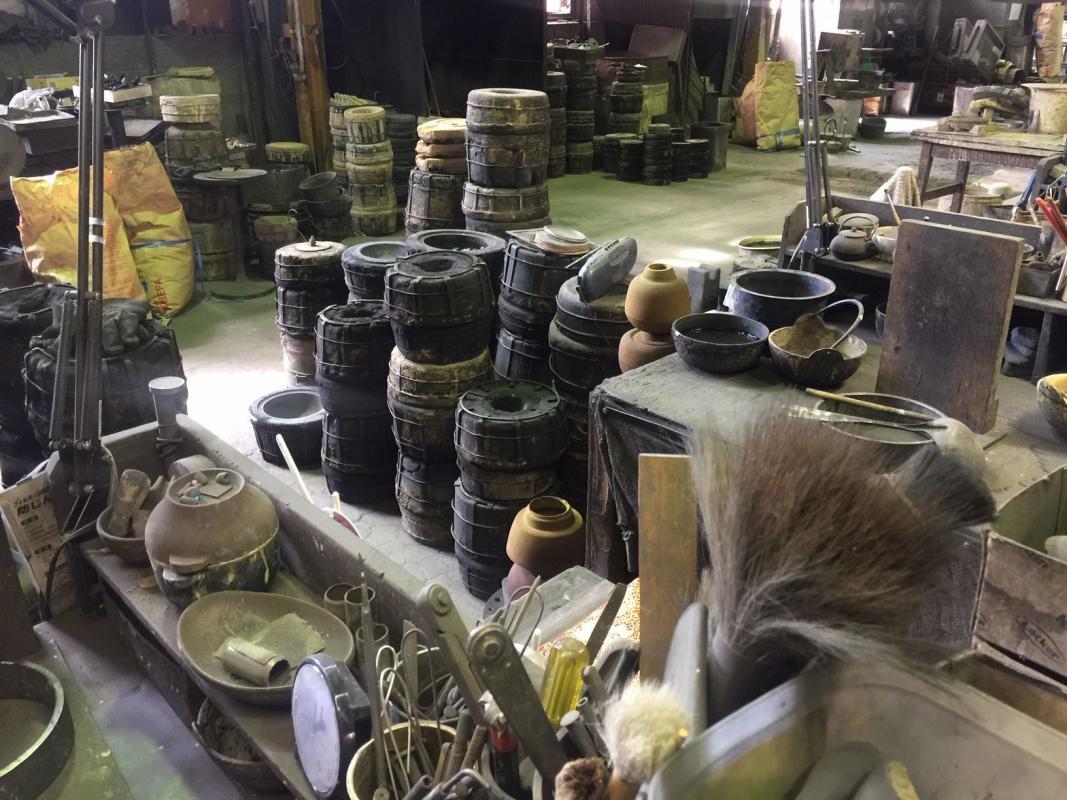If you like using cast iron teapots or kettles, you might have heard of special ironware from Japan called Nanbu Tekki. Nanbu Tekki is not as well-known outside of Japan. But in Japan, this type of cast iron is considered the best ironware for teapots and kettles. And the ironware often sells at a premium. But what is Nanbu Tekki, and why does it cost more?
If you visit Japan, you will find Nanbu Tekki used in tea ceremonies, on display in museums, and for sale in tourist shops. Let’s find out what separates Japanese cast iron from cheaper mass-produced ironware.
Here’s What You Can Learn From This Article
- What is Nanbu Tekki?
- Learn the history of Iwate cast iron
- How Nanbu Tekki almost disappeared and how it has survived
- How artisans make bespoke cast iron kettles
- Why do many tea drinkers prefer to use cast-iron teapots and kettles?

If you’re interested in purchasing a cast iron teapot or kettle, you will come across the term Nanbu Tekki. But what exactly is Nanbu Tekki?
If you are short on time, here is a quick answer: Nanbu Tekki is ironware produced in the Iwate Prefecture of Japan. 
The History Of Nanbu Tekki
The Origins
“Nanbu” or “Nambu” originates from a feudal clan called Nanbu-Han. This clan ruled the northeastern part of Honshu for over 700 years. The Nambu clan established the cast iron industry in the region. And since the area had easy-to-access resources to make ironware, the sector quickly formed.
However, Nanbu-Han leaders in the 17th century had bigger plans and wanted their lands to grow economically and culturally. So, they invited well-respected artisans across Japan to help make and improve what would later be called Nanbu Tekki.
In the 17th century, the rulers invited respected artisans in Japan to design and make cast iron products.
The plan worked, and the ironware became a local specialty. The ironware became treasured gifts among feudal lords and the ruling classes. The ironware was also very expensive, with very few able to afford such a luxury item.
It’s still expensive today for local artisans’ bespoke kettles and teapots. But fortunately for us, technology has advanced. And we don’t need to be a Lord to be able to afford a Japanese kettle.
If you are lucky to have a kettle, you may want to head to our cast iron guide. It will give you tips on how to look after your kettle correctly.

What Does Nanbu Tekki Mean?
Let me break down the word to make it easy to understand. Nanbu 南部 was the name of the ruling clan that ruled much of the Tohoku region for over 700 hundred years. While Tekki translates to ironware 鉄器. So Nanbu Tekkei is the Nanbu clan’s ironware.
Nanbu Tekki Must Be Good. The Japanese Have Used It For Hundreds Of Years.
The manufacture of Nanbu Tekki in Japan dates back over 400 hundred years. Needless to say, Japanese artisans are experts in making cast ironware. And they still produce some of the most beautiful handmade ironware ever. Although for a hand-crafted kettle, expect to pay a handsome sum.

Many artisans still make ironware using painstaking traditional methods, such as handmade clay molds. This is one of the reasons why Nanbu Tekki is a protected art and why it’s so expensive. Luckily for us, there are cheaper Nanbu Tekki options available. These products are made in sand molds instead of traditional clay.

Is it challenging to use a cast iron teapot? No, they are easy to use. To learn more, here is an article on how to use a cast iron teapot.
The Champagne Of Ironware
Today, ironware from Morioka City and Oshu City are the main areas with the naming rights to use Nanbu Tekki. Like the region of Champagne in the northeast of France, the word Champagne is protected. The Nanbu Tekki name is also copyrighted. The only ironware produced in Iwate is Nanbu Tekki.
Unfortunately, many overseas manufacturers and distributors falsely label their products as Nanbu Tekki. So I recommend asking, “Where is the product made?” before purchasing.
Currently, there are over 70 companies that produce Nanbu Tekki. Popular products include kettles, cast iron teapots, wind chimes, and sukiyaki bowls.

When Did Nanbu Tekki Become Popular?
Around 1750, Nizaemon Koizumi, the 3rd, invented the tetsubin. Also known as the Japanese kettle. The kettle had a handle and a short pouring spout. Sure, this invention is not groundbreaking. But the tetsubin is much easier to use and carry than the chagama. The chagama has a bowl-like appearance and was often used before the invention of the tetsubin
To learn more about the tetsubin, click the link for an in-house article.

Nanbu Tekki In Post-Modernization Japan
Cultural Art
Thanks to the development of railroads and the Meiji government policy to promote modern industrial growth. The Nanbu Tekki industry was redeveloped and modernized. In 1914, the Nanbu Casting Institute was established, and Nanbu Tekki was recognized as having cultural importance to the country. And it was raised to the level of fine art.
Ironworks During The Second World War
The Second World War had a devastating effect on the ironworks industry in Japan. Regulations by the Japanese government in 1938 shifted the industry’s focus to the war effort. Sadly, a lot of antique ironware was destroyed to produce items such as canons.
However, some local craftsmen refused to let their proud heritage die. They joined together as a group to work for the preservation of Nanbu Tekki’s art. There are also stories of villagers protecting cast iron artifacts from authorities. For example, locals from Shiroishi successfully prevented a historical bell from being melted down.

A Downward Trend In Demand In The 1960s
After the war, lifestyles changed. The demand for Nanbu Tekki decreased. In the 1960s, aluminum and stainless steel products took market share from traditional ironware.
Nanbu Tekki Today
Today, Nanbu Tekki is having a resurgence in popularity. Today, both new and vintage Nanbu Tekki are sought after. Its distinctive character is still apparent in both traditional and modern designs. People worldwide have gained a fresh appreciation and love for Japanese cast iron.

An authentic handmade Nanbu Tekki kettle can range in price from ¥50,000 to around ¥300,000 (about $450–$3,000). But you can pick up sand-molded Nanbu teapots for a fraction of this price. And if you want to learn the difference between a cast-iron kettle and a teapot, click the link.

How Do Artisans Make Traditional Nanbu Tekki Kettles?
First, The Mold
First, artisans make a mold based on drawings. Then, artisans pour special molding sand into a cylindrical wooden frame. The frame is to make the body of the kettle. Meanwhile, the pouring spout gets its own little mold.
Artisans also make individual clay molds for bespoke pieces. This time-consuming process separates a Nanbu Tekki Tetsubin from low-cost manufacturers.
Decoration
Unique patterns or drawings characterize Nanbu Tekki from other cast iron. Traditionally, artisans press Nanbu Tekki designs into the clay mold by hand.
Artisans use tools to press these designs into the mold while wet. (Interestingly, some tools for pushing are from the Edo Period and are still used today.
A dot pattern called Arare is an iconic Nanbu Tekki pattern. The dots are painstakingly and precisely pressed into the still-wet mold.
Next, the spout’s mold and the kettle’s body are attached. Then, artisans bake the mold to make it completely dry.
Casting The Design
After the mold is baked, it is checked for any imperfections. Once satisfied, artisans pour molten iron into the clay mold. After the casting process is complete, the core is taken out. The tea kettle is baked again in charcoal or a kiln.
This casting method creates an oxide film on the iron that prevents rust. This is a unique feature of Nanbu Tekki.
Finishing Touches
Finally, the caster will check the finished product for evenness and smooth raw edges with a grinder.
(A Nanbu Tekki tea kettle with a fire-kiln finish. It is not enameled and releases a little iron into the boiled water. Some Japanese believe this makes the water for green tea taste better).
Traditional Lacquering
The handle is attached after covering the outer surface with lacquer for rust prevention.

Characteristics Of Nanbu Tekki Ironware
- Ironware has excellent heat retention properties.
- You can use some kettles on induction cookers. However, I recommend asking the manufacturer first.
- Nanbu Tekki is beautiful and comes in an array of colors and designs. If you want a colorful teapot or kettle, you might want to check out Iwachu cast iron.
Nanbu Tekki Has Stood The Test Of Time.
Nanbu Tekki symbolizes how traditional Japanese craft has endured over hundreds of years. It hasn’t been easy for the industry, but it’s flourished because of the foresight of the Japanese government. The laws protecting the industry ensure the tradition is kept alive, and future generations of artisans will make beautiful ironware.
The foundries in the region of Iwate have maintained their traditions and make some of the world’s finest ironware. If you’re looking for a cast iron teapot or kettle, look no further than Nanbu Tekki.
Resources
- https://japan-brand.jnto.go.jp/crafts/metal_work/8/
- https://artsandculture.google.com/exhibit/JgKCPlRYx2bcKA
- https://en.wikipedia.org/wiki/Chagama
- https://www.nippon.com/en/features/c00617/a-tradition-ironed-out-over-the-years-the-cast-iron-creations-of-okamaya.html
- http://japancraft.co.uk/cast-iron-information
- https://journey-of-japan.com/article/222/en









I have what I think is a Nanbu Tekki Sangendo cast iron warming sizzler/cooking plate shaped like an Ox. I’d like to know what the handle would have looked like, it appears to be broken off. I can send a picture.
Hi Scott
Thanks for your message. Japanese tend to favor simple styling, and I suspect your serving plate is from one of Japan’s northern neighbors. However, you’re welcome to send a picture, and I’ll have a look over your ironware. Here’s my email, booniehicks@gmail.com
Cheers Scott.